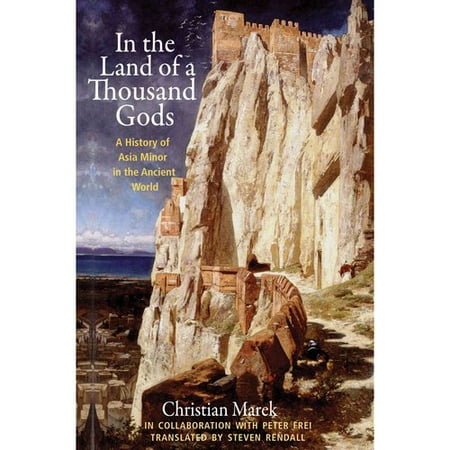
After two millennia, the legacy of early Greece continues to fascinate scholars and tourists. Less appreciated may be its neighboring realm, which spawned both rivals to and recipients of Hellenic control. Asia Minor, its very name standing for the exotic beyond the ethnocentric Mediterranean, bridges the East and the West. As events from today's headlines verify, the tension between the Asian and European, the Middle East and the great sea over which so many powers have battled for power exerts itself upon this heartland, where from prehistory on, many forces emanate from an epicenter.
In the Land of a Thousand Gods tells the story of this cultural and political hub, from the Stone Age to the Roman Empire. A massive work, it began with the research into cuneiform and hieroglyphics provided by Peter Frei, who taught ancient history at the University of Zurich. His student and successor, Christian Marek, completes this survey. Steven Rendell translates the 2010 German edition and incorporates a few updates to a compilation encompassing classics, Oriental Studies, linguistics, archaeology, prehistory and anthropology. Supplemented by necessary genealogies, maps, documentation and black-and-white illustrations, these appendices total over 170 pages. The text itself, while densely printed and closely argued, nevertheless aims at the general, if diligent, reader.
Details linger within the academic exploits recorded by Marek on every page, as excavators and discoverers vied to leave their mark upon the ruins opened up to acquisition by those in the vanguard of European colonial expansion. Inscriptions upon stone drove Phillipe Le Bas, as the 19th century closed, to boast of his triumph. "I left Mylasa, having squeezed every drop of juice from the lemon. In future, travelers can dispense with going there. I have not left them the slightest kernel to find."
This eagerness to claim and conquer spurred many in centuries previous, too. The region rests on its rubble. Buildings were often destroyed to excavate even older sites. Dams flood nowadays more and more of Anatolia, hastening current archaeological digs. In the past, of course, conquerors eradicated peoples and razed cities, only to have their inhabitants, returning or replacing those victims of war, raise up new edifices, streets rising to shove levels higher. These striated remnants challenge scholars who delve beneath the surfaces, over thousands of years of occupation. From coinage to economics, religion to poetry, science and strategy, Marek allows patient students a comprehensive guide to this evolution from the Bronze and Iron Ages to the incursions of the Persians and then their bitter enemies, the Greeks. The Hellenistic polity in the wake of Alexander the Great gives way to the enforced Pax Romana. Then, the Roman republic capitulating to the imperial imposition of order, the provinces of Asia Minor emerge. Administration and socio-political considerations are then covered.
The results in this hefty volume will overwhelm any casual inquirer, but this book stands as a reference for anyone needing information about nearly any aspect of this period and this landmass. While in-depth as a whole, the chapters, needing to span so much, can race by. The reader will find that the sudden conclusion, as the Byzantine Christian establishment supplants and soon attempts to eliminate its pagan Roman forebears, comes as hastily as the onset of the new faith must have appeared to many who had long lived in Anatolia and its environs, worshiping a thousand gods. (Spectrum Culture 11/11/16; Amazon US 12/9/16.)






















No comments:
Post a Comment